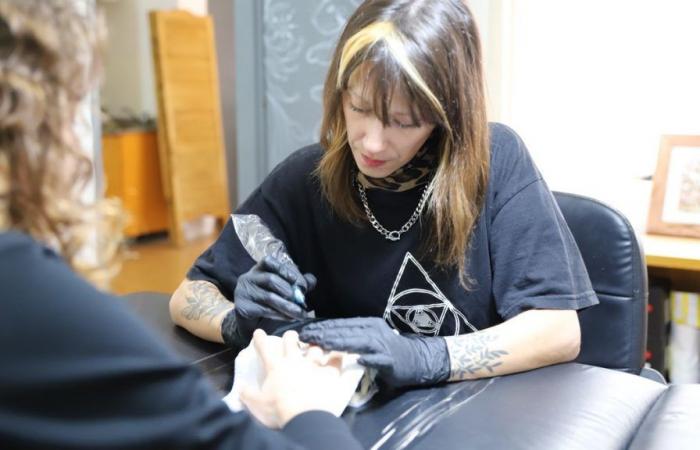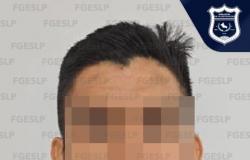SFP Lucía Eberhardt tattoo artist (16).JPG
Sebastian Fariña Petersen
“My search had been more of an aesthetic representation, but it was much later that I acquired the message, or with what tools I could communicate certain things that were good for me,” he explains.
Her process as a tattoo artist
The tattoo was also there, but beyond getting tattooed a couple of times, admiring and recording in his photos the work that some acquaintances did, he did not choose it, he was not interested. Until someone saw it in her, he saw that from the design to the tattoo there was a single stroke, he saw the overflows, the open questions, what was not completed and then he proposed to teach her. Lucía accepted and without imagining, she opened an immense door that today is not only her daily life, but a way of bringing to light what inhabits her and doing it for others. Or as she says: “Tattooing, for me, is a very complete way of expressing. I realized some time after I started doing it. I began to understand what it entails, what a great channel it is to communicate and connect with other people.” “A bond of permanence is established, which first requires interpreting the desire, to translate it into the body,” he said.
He started tattooing oranges and grapefruits. Then she bought a synthetic skin where she practiced over and over again, until she finally took courage and pricked his guide: a very small triangle with little dots that she struggled to make. “I was always very aware that she was piercing skins and in light of that: a lot of respect. The first few times it was very difficult for me because I didn’t want to hurt him. That helped me, because I went from less to more, I gained confidence in my tattoo. “It was an evolutionary process,” she said.
Lucía Eberhardt Tattoos (6).jpg
After tattooing friends, former school and university classmates, family, people who came asking about her tattoos, Lucía left her home and began tattooing in different studios that opened their doors to her and where she continued her learning process. Until she was able to gain experience, equip herself better, but above all find confidence and that was when she opened Las Flores, her studio.
Las Flores, your tattoo studio
Las Flores was born from Lucía’s search and need to have not only a brand, but a space for creation. For more than 5 years, she has also been a place of learning, exchange, and sharing with other women linked to art. There Lucía explores what is already part of her identity, her ways of putting on the skin of others what she herself inhabits, through a tattoo that takes up elements of botany, the organic, geometry and symbology. “I try to make them be living pieces, that can generate a certain dynamic in the body. I really like working with textures, small details within large pieces, line and point, pointillism, little sweeps, subtle shadows. I like to play with those more natural phases, rather than the classic ones,” she says about her work.
SFP Lucía Eberhardt tattoo artist (1).JPG
Sebastian Fariña Petersen
It is also the place where a necessary exchange is generated with people to give shape to what they will carry forever on their skin. There are simple pieces that require nothing more than an exchange of messages, which can be executed with ease. Some people also come with very specific ideas, which have some very specific symbolic, emotional or aesthetic loads. But there are complex works that require a face-to-face meeting, which for Lucia represents a fundamental instance, because it is from reading the gestures, the forms, what they express, in which she can form images. And in that exchange is precisely where the imagination, the desire of the person and the art of Lucía come into play.
put the body
The first records of tattoos date back more than 5 thousand years. From the mummy of the priestess Amunet in Egypt who had lines and dots spread across her body, to Ötzi, the man who was frozen for 5,300 years, and who had 61 tattoos on his skin made with a sharp element and charcoal. In Ancient Greece they were used to distinguish slaves and in Ancient Rome to distinguish army deserters. And so throughout history. The tattoo was part of ritual, religious, collective processes or forms of discipline and social control that were mutating. It was from the middle of the last century, where the body began to look at itself differently, to go through a process of uncovering, with a greater degree of freedom: to take on other signifiers, which allowed more subjectivity, more identity to be built from it.
Lucía Eberhardt Tattoos (8).jpg
“Tattooing is modifying your body forever, until that body ceases to exist. I like to think that you are adding something to it. The tattoo allows a question of positive aesthetics. Many people, especially women, want to modify their body and find in tattooing a way to do so, to give new meaning to scars or marks from some disease; to feel more comfortable and secure with some part. The tattoo is powerful and you love it, because you say, I feel beautiful. I go through it, I do this action and I am totally transmuting”, explains Lucia about what she finds in Las Flores.
SFP Lucía Eberhardt tattoo artist (13).JPG
Sebastian Fariña Petersen
In getting a puncture there is a degree of adrenaline, it is the possibility of making a perpetual decision. This generates a body chemistry, a state that gives pleasure, which possibly leads many people to constantly want to get tattoos. And although it is something that Lucía also enjoys, what moves her most, apart from the aesthetic or the artistic fact, is the opportunity to help people feel better, to recognize themselves as stronger in front of the mirror.
And with the same respect and love that she tattoos others, she also tattoos herself as a gift. She chooses to tattoo moments of change, turning points and in some way she allows herself to map her own skin, in a kind of meditation, in an intimacy of pain. Because ultimately, a tattoo is a trace of a social time, a story of its own, a moment that we choose to put on our skin.
The permanent in an ephemeral world
The first time she finished a tattoo that completely moved her was the one she did on Martín’s chest. A hand with an eye in the center and an ornament loaded with other symbolism that covered it from shoulder to shoulder, where she allowed herself to play, create, as if she herself inhabited that skin. For that she spent a couple of years, it was a long process, Lucía was learning and she also did not have the machines that she has today. She always enjoyed tattooing what is in front, what says “here I am”: breasts, backs, bellies. But more, the power of having the freedom to create from her perception, from the meaning that she gives to things, or being chosen for her work, minimal and subjugating of her, with the awareness that That will be there forever.
Lucía says that this is a difficult time for tattoos, a little because of the economic situation, a little because there is a degree of compulsion to tattoo anything that is far beyond the possibility of generating an artistic fact, but above all because of the level of demand and lightness that exists when it comes to showing what is done.
SFP Lucía Eberhardt tattoo artist (6).JPG
Sebastian Fariña Petersen
Before, people found out that someone tattooed through word of mouth, from friends, from a piece of paper that they posted in the business or at the bus stop, now if that doesn’t happen on social networks, it simply doesn’t exist. And social networks require permanent content creation. “The algorithm is exhausting, it is very perverse, because if you are not giving it what it asks for, it takes you out of circulation. And it is impossible for there to be any artistic event with the immediacy or rules that it proposes,” explains Lucía, about a moment that is not only critical for tattooing, but for art in general.
Although there is something in all of us that moves at such a speed that it does not even allow us to think about it, in a scenario where the disposable is what prevails, the tattoo has the advantage of resisting, of clinging to the body, to the real. Lucía knows that it is a moment that she will also experience, like others, who always found her creating the illusion of another possible world in her work. And although the imposition of the ephemeral distresses her, the permanent saves her, because art is her pulse, her refuge and her faith.
You can learn more about Lucía’s work on the IG @lasfloresstatt and @lvxtttnuevo






